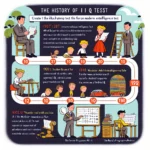The Intriguing Evolution of IQ Testing: Tracing the Historical Milestones
Intelligence quotient (IQ) testing is a tool designed to measure a person’s intellectual capabilities relative to their age group. This fascinating branch of psychological assessment has undergone significant evolution since its inception. Understanding the history of IQ testing is crucial not only for psychologists and educators but also for individuals seeking insight into their cognitive abilities.
IQ Testing Origins: The Journey Begins
The history of IQ testing traces back to the early 20th century, when French psychologist Alfred Binet was commissioned to develop a method for identifying students in need of educational assistance. Teaming up with his collaborator, Théodore Simon, Binet introduced the Binet-Simon Scale in 1905, which was revolutionary as the first standardized intelligence test.
The Binet-Simon Scale and the Advent of the IQ Concept
Binet and Simon’s initial test evaluated children on various tasks, such as memory, attention, and problem-solving skills. The test results led to the calculation of a child’s ‘mental age,’ which could be compared to their chronological age. William Stern, a German psychologist, later introduced the term ‘Intelligence Quotient,’ referring to the ratio of mental age to chronological age, multiplied by 100 to avoid decimal points.
The Stanford-Binet Intelligence Scales: A Standard Emerges
When the Binet-Simon Scale crossed the Atlantic, it was revised by Lewis Terman, a Stanford University psychologist, resulting in the Stanford-Binet Intelligence Scales. The Stanford-Binet remains one of the most popular instruments for IQ measurement and has undergone multiple updates to address evolving needs in assessment.
The Group Testing Movement and World War Efforts
The First World War highlighted the need for large-scale, group-administered intelligence tests, leading to the development of the Army Alpha and Beta tests. These instruments aimed to facilitate military placement by assessing recruits’ cognitive abilities. The success of this group testing method prompted the further application of IQ tests within educational and occupational settings.
The Wechsler Scales: Broadening the Scope
David Wechsler introduced a new approach to intelligence assessment through the Wechsler Adult Intelligence Scale (WAIS) in the 1930s, followed by tests for different age groups. Wechsler’s scales emphasized the multifaceted nature of intelligence, encompassing verbal comprehension, perceptual reasoning, working memory, and processing speed.
IQ Testing and the Modern Landscape
Today, IQ testing has been shaped by advancements in psychology and technology. Detailed understandings of intelligence have prompted more nuanced testing methods, incorporating aspects like emotional intelligence and multiple intelligences theory. Additionally, computerized testing has enhanced the precision and efficiency of administering IQ assessments.
Ethical Considerations and Cultural Bias
Through its history, IQ testing has also faced scrutiny concerning ethical considerations and cultural bias, leading to ongoing refinement to ensure fairness across diverse populations. Questions about the implications of test results for an individual’s potential have persisted, prompting a vital dialogue on the role of IQ testing in modern society.
The Legacy of IQ Testing
IQ testing’s history reflects a complex tapestry of scientific discovery, practical application, and societal change. From the Binet-Simon Scale to contemporary tests, the journey of IQ assessment illustrates humanity’s endeavor to understand and measure the cognitive aspects of intelligence, shaping education, employment, and our broader comprehension of human potential.

